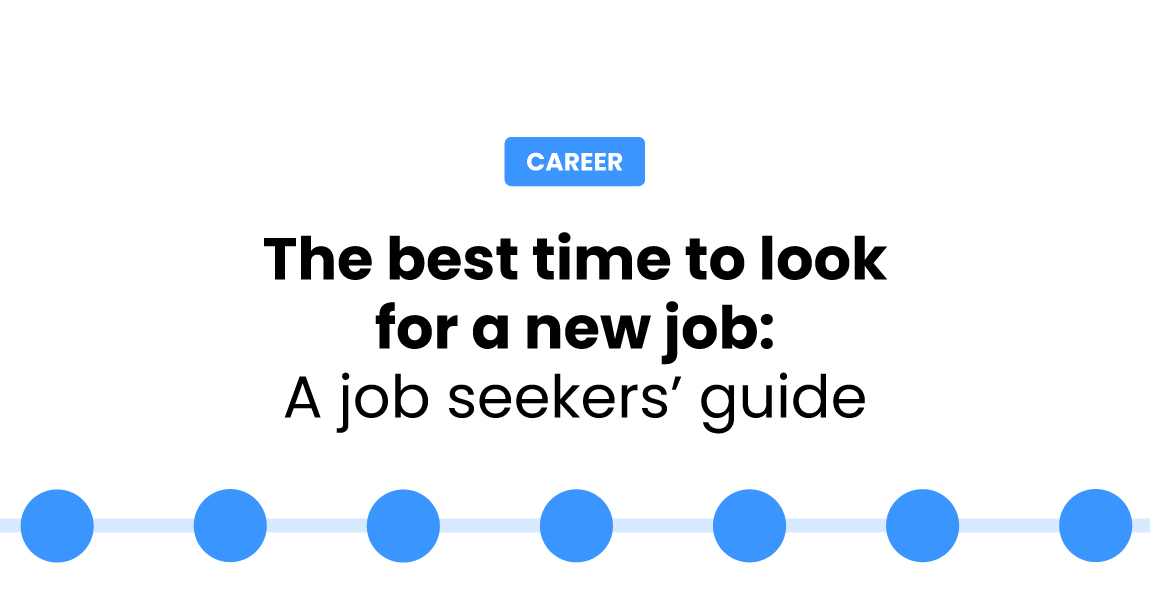When taking a massive leap and choosing to step out of one’s comfort zone, it’s vital to be proactive and consistent. These are the basic rules for landing a brand-new, more fitting career opportunity. But there’s an extra question to answer: when’s the best time to look for a new job? Well, we’re here to let you in on hiring trends by month. So keep reading, and secure some interviews, positive responses, and offers.
What is the best time to switch companies?
Nearly everyone feels uninspired at work from time to time. However, if the feeling persists, it could be more than a mild Garfield syndrome or an acute case of Monday intolerance. In fact, it is likely a sign that it’s time for a change. There are quite a few reasons for job dissatisfaction. Low pay and the lack of opportunity for personal and professional growth are at the very top of the list. Poor management is another valid justification for those who choose to resign. And finally, being short of true value and meaningfulness drives countless workers to seek career opportunities elsewhere.
Now, according to some experts, the best time to look for a new job is after 2-3 years with a company. Still, if you’re unhappy at work, your job hunt should start sooner. As a matter of fact, we live in an era where job hopping isn’t necessarily a bad thing. Quite the opposite, actually – it’s something of a trend! And it is proven that those who switch jobs more frequently advance faster and get higher raises. So, if you feel burned out, let down, or just chronically bored, start ogling new employers. And follow the simple rules and timing we’re about to discuss.
Best and worst times to look for a job
If you’ve been overwhelmed and unmotivated or underpaid for quite a while, that’s your cue. It’s probably a good time to look for a new job. But when is the hiring season, and when not to raise your expectations?
Each month has its unique pros and cons when it comes to recruiting and reviewing applications. The beginning of the year is typically favorable for those who intend to turn the page and get hired. Spring is also known as a great season to look for the next challenge. In truth, these months are ideal for completing the onboarding processes – from the management’s point of view. Since summer usually entails a bit-by-bit type of pace and inspires a collective ode to hedonism before elbow grease, recruiters, HR personnel, and managers often strive to finalize their hiring efforts in April and May. Fall months are also very promising. So even though “back to school” posts, ads, and whatnot are somewhat stale, most employers (and employees) actually do cling to those postulates. Unconsciously, sometimes. And so landing a fantastic new job before November is generally more achievable.
What is the best time to look for a job?
Even though January and February are known as the months when people are most likely to get hired, you may encounter slower-than-usual responses in the first two weeks of January. This happens because many employees still need to return from their vacation. But generally speaking, these are pretty great months to camp on the potential employers’ doorsteps.
Now, as we said, springtime is a fantastic period to pursue brand-new jobs. However, there’s one tiny disadvantage – other job seekers rely on this information too. So, it is possible that the competition will be higher if you apply in April or May. September and October are the ultimate slices of utopia for people on a mission to seize the next career opportunity. Everyone is still feeling fresh and well-rested after their vacation, and both hiring managers and candidates are in the mood for some go-getting. Also, as we approach the coldest months, everything starts to feel urgent. Blame it on human nature or Game of Thrones, but that’s how recruitment and hiring are, my sweet summer child.
It’s official: February is a peak hiring month!
If we had to choose a perfect month to look for a new job, it’s definitely February. Here’s why:
- The holiday season’s absence with a dash of do-nothingness is finally over,
- Companies have their aims in order and their budget on point,
- The competition is more likely to go after your (mutual) dream job in a month or two.
Lastly, if a company posts a vacancy in January, this is the moment when they’ll start to schedule interviews.
Bonus tip: What day of the week is best for a job search?
Studies show that most people apply for new jobs on Tuesdays. And because of that, many consider this day to be the ideal workday to submit a resume. But still, research suggests that applicants have a 20% success rate if they go by this rule. So, Tuesdays are less than perfect, to be frank. Surprisingly (or not), it turns out that Monday grants you the best odds of receiving a positive response from a potential employer. The math is simple – while Tuesday drives the most application traffic, Monday is the ultimate productivity-fused day of the week. It gives you a 10% higher chance of being noticed and interviewed. Since recruiters and hiring managers are also prone to embracing a fresh start, they’ll undoubtedly be thorough yet quick when reviewing CVs, portfolios, and cover letters.
⚠️ Lastly, make sure not to apply on a Saturday. Research shows that this day offers only up to a 14% success rate.
The worst time to look for a new job
Typically, December is the slowest month for job seekers and hiring managers. Firstly, it is because people tend to use a substantial chunk of their vacation time during this month. They often travel out of state or make other holiday plans. So, during times of festivity and starry-eyed resolutions, it is common for businesses to catch employees working at a slower pace.
Also, this is the month when companies review and restructure their budgets. They dedicate their time to performance reviews and hand out bonuses, which can leave less financial means for new employees and less time to evaluate future hiring needs.
Summer is rarely the high point of a hiring season.
July and August could be challenging months for a job seeker. Much like in December and early January, vacations and getaways could get in the way (if you get the pun) of your hot, lucrative, and inspiring new role. For instance, if a company’s recruitment specialist or hiring manager is a parent, the odds of them not taking a glance at their email, LinkedIn, or firm’s ATS are close to the absolute 100. Now, not all companies share the same policies. And not all recruiters and managers have the same routines and preferences. So, yes – you should still be reviewing job postings and reaching out to recruiters. You could still land an offer, even if a specific time of the year is notorious for being lazy and passive.
Get ready for a job search.
Regardless of whether the hiring season is in full swing or postponed due to mass enjoyment, financial planning, or something else, every active and passive job seeker must be armed with a few tricks. By following a few simple rules and tested tips, you’ll certainly increase your chances for success when the moment comes. From a freshly updated resume to reaching out, applying, and following up – make sure to know and use these techniques.
Boost your resume and online presence
As you move forward and grow throughout your career path, you will learn new skills and refine the ones you’ve already had. Simultaneously, you will need to tailor your resume and update it regularly. The best way to keep your CV and LinkedIn profile fresh is by reviewing and revamping them quarterly. That way, you’ll be ready to apply for all the enticing job opportunities that pop up while you scroll. You could try to keep up by setting a reminder on your calendar and scheduling these resume renewals.The fundamental rule to follow when creating or refining a resume is to keep it clear, concise and boosted with the main keywords. Plus, it should stay as short and sweet as possible, so do your best to keep it two pages long at most. And conclusively, be honest but not too modest. The same guidelines apply to your LinkedIn profile. You can make recruiters come to you by choosing your headline and job title smartly, adding a brief paragraph about your experience and interests, and focusing on telling more about the last two positions you’ve held. Oh, and don’t forget to connect with other industry professionals and recruitment specialists.
Grow your set of skills
Acquiring an in-demand skill or two is always a good idea – especially if you’ve decided that right now is the best time to look for a new job. But aside from the “hard skills” and industry-specific knowledge (that all recruiters and interviewers will certainly appreciate), you should have your soft skills refined too. Communication, collaboration, and a strong work ethic are the traits and abilities you must continuously improve. Time management, organization, and independence are also the right stuff from a hiring manager’s perspective. And there’s also a matter of flexibility and adaptability, which are essential qualities to obtain and better repeatedly. Now, as for the ways to amplify those capabilities and expertise needed to get the daily duties done (in a timely and efficient way), you could enroll in some online courses. These can come in handy regardless of whether you’re looking for an on-site or remote job.
Revisit your actions to get more application responses
Even the most efficient recruitment and hiring processes take time and patience – from all parties. So, if you’re keen on landing that career opportunity, don’t stall, and don’t lose focus. The season might be slow, but your actions should be smart and consistent. And if you’re not getting responses from the companies you’ve wanted to get in, follow these steps for move favorable outcomes:
- Double-check whether you’re a good match for the position by taking a second (more careful) look at the job description and comparing it with other employers and your previous experiences,
- Reassess your resume and make sure that you’re using the right keywords that fit the job ad catching your attention,
- Set a weekly application goal and stick to it. And as a bonus prize, reward yourself in small yet important ways for reaching these goals each week.
While scrolling, seeking and waiting for a reply, don’t miss out on practicing your interview skills. You should keep prepping a variety of responses to the most common question for your position and niche.
Reach out to recruiters
According to surveys, recruiting and talent acquisition specialists account for 5% of all US LinkedIn profiles. And more than 87% of them use this network weekly! So, all you have to do is build up your profile, craft a personalized connection request, and start the conversation. Additionally, you can also rely on InMail to touch base with recruiters, even if you’re not connected yet.
Now, much like when you’re tailoring a profile and its main sections, such as the headline, it’s vital to use keywords when approaching a recruiter. So don’t fail to come up with a catchy and perfectly clear subject line before hitting “send.”
Seize the best time of year to look for a new job
Although there is such a thing as the absolute best time to look for a new job, you shouldn’t overthink it. Because peak hiring season or not, you will get an interview scheduled in no time if you do your leg work and homework. So keep your resume fresh, your skills up to date, and the apply button warm.
👉 Exploring new jobs? You’re just in place.




